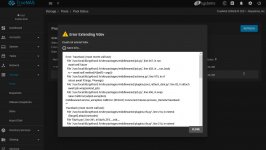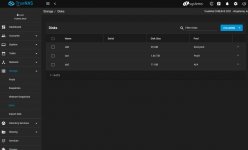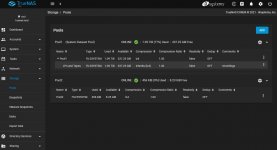I have successfully installed both TrueNAS Core and TureNAS Scale on VMware Workstaion Player under Windows 10 professional edition. But except from host PC, I cannot access TrueNAS via web user interface in all other devices in my local area network at home. As a newbie, I'm quite frustrated. Now only the host PC can access the TrueNAS normally. By the way, I did not change any default option as I dare not configure network interfaces.
-
Important Announcement for the TrueNAS Community.
The TrueNAS Community has now been moved. This forum has become READ-ONLY for historical purposes. Please feel free to join us on the new TrueNAS Community Forums
You are using an out of date browser. It may not display this or other websites correctly.
You should upgrade or use an alternative browser.
You should upgrade or use an alternative browser.
Can't access TrueNAS via web user interface except from host PC of VMware Workstaion Player
- Thread starter xq0404
- Start date
jgreco
Resident Grinch
- Joined
- May 29, 2011
- Messages
- 18,680
I dare not configure network interfaces.
VMware Workstaion Player under Windows 10 professional
So how were you expecting this to work, then? It is doing EXACTLY what is expected. Workstation creates networks by default under a NAT engine. When you go into the Virtual Machine Settings and click on "Network Adapter", under the Network connection properties it'll show you as attached to "NAT: Used to share the host's IP address". If your PC is on wired ethernet, you can probably change this to "Bridged" mode to place the VM on the same ethernet as your home network. You probably won't be able to do that for wifi; wifi is weird about bridging.
The original web user interface for TrueNAS Core is 192.168.174.128. The web user interface for TrueNAS Scale is 192.168.174.129, Nameserver (DHCP):192.168.174.2What address do you get if you let it DHCP?
Should I have turned off WebDAV service? Or should I leave the "copy physical network connection status" box beside "Bridged" option unchecked?
Last edited:
My home virtual NAS is installed on my desktop PC on wired ethernet (my WiFi router has Ethernet ports). But I could not access the virtual TrueNAS via a web user interface from my Mac Mini and a Lenovo laptop through home wifi.Well, I'm trying to understand what your network configuration is. Usually when things "don't work" it's because of a bad network design.
Perhaps you could explain.
I think I have succeeded. Thank you so much. In configuring the network, just change to "Bridged" mode and choose "user-defined" VMnet0.Well, I'm trying to understand what your network configuration is. Usually when things "don't work" it's because of a bad network design.
Perhaps you could explain.
I have learned a lot in the past few days from all this virtual configuration of NAS. But it turned out a NAS at home is not something I need urgently now. I might as well resort to accessing shared folders on Windows 10, which is much easier and more practical. That's because copying data to and from TrueNAS is painfully slow. I have finally figured out how to reliably use Windows 10's built-in networking mechanism. I also found out that TrueNAS Core cannot expand an exising pool (despite showing a successful operation) as I originally hoped although I added an additional virtual hard drive (vmdk at an allowed maximum capacity of 2040 GB ).
Last edited:
jgreco
Resident Grinch
- Joined
- May 29, 2011
- Messages
- 18,680
found out that TrueNAS Core cannot expand pools as I originally hoped
Well, that comes as shocking news to those of us who expand pools on a semi-regular basis.
no matter how many additional virtual hard drive (vmdk at an allowed maximum capacity of 2040 GB ) I added.
That, however, is a recipe for disaster. See
"Absolutely must virtualize FreeNAS!" ... a guide to not completely losing your data.
[---- 2018/02/27: This is still as relevant as ever. As PCIe-Passthru has matured, fewer problems are reported. I've updated some specific things known to be problematic ----] [---- 2014/12/24: Note, there is another post discussing how to deploy a small FreeNAS VM instance for basic file...
www.truenas.com
There appears tp be a bug with a vmdk that can set a maximum capacity of 2040 GB and that can automatically enlarge capacity gradually under a VMware workstation configuration. The TrueNAS at first can expand pool accordingly. Then somehow the pool stops adjusting the virtual drive capacity as the vmdk enlarges bit by bit, let alone the volume of an additional attached 2040 GB virtual drive that I added .Well, that comes as shocking news to those of us who expand pools on a semi-regular basis.
That, however, is a recipe for disaster. See
"Absolutely must virtualize FreeNAS!" ... a guide to not completely losing your data.
[---- 2018/02/27: This is still as relevant as ever. As PCIe-Passthru has matured, fewer problems are reported. I've updated some specific things known to be problematic ----] [---- 2014/12/24: Note, there is another post discussing how to deploy a small FreeNAS VM instance for basic file...www.truenas.com
I want to use NAS to play lossless high-res music files. But come on, I can only transfer or receive data at a rate of 5-20 MB/s even from the host PC I installed VMware Workstation Player and TrueNAS.
Last edited:
jgreco
Resident Grinch
- Joined
- May 29, 2011
- Messages
- 18,680
You're not supposed to be enlarging VMDK's holding ZFS partitions. You can add additional disks, but at the point where you are trying to add terabytes of space, you should be using real disks via PCIe passthru. VMware Workstation is not going to do well under this kind of abuse, and something will go <<sproing>> sooner or later, probably sooner. The article I gave you wasn't really a suggestion. It's the way you need to do things if you want your data to be safe and secure.
Perhaps creating fixed-capacity vmdks instead of automatically-adjusted virtual drives and gradually adding them is another option so that the pool will not be at a loss to resilver and reclaim space while expanding capacity.You're not supposed to be enlarging VMDK's holding ZFS partitions. You can add additional disks, but at the point where you are trying to add terabytes of space, you should be using real disks via PCIe passthru. VMware Workstation is not going to do well under this kind of abuse, and something will go <<sproing>> sooner or later, probably sooner. The article I gave you wasn't really a suggestion. It's the way you need to do things if you want your data to be safe and secure.
I tried once again after scrubbing and resilvering the pool's Vdev, this time by adding a smaller virtual hard drive, but it could not even extend itself to become part of the pool as the previous larger VMDK. The only other choice is to create a second pool. So I have no choice but to give up on TrueNAS for the time being.
Attachments
Last edited:
Important Announcement for the TrueNAS Community.
The TrueNAS Community has now been moved. This forum will now become READ-ONLY for historical purposes. Please feel free to join us on the new TrueNAS Community Forums.Related topics on forums.truenas.com for thread: "Can't access TrueNAS via web user interface except from host PC of VMware Workstaion Player"
Similar threads
- Replies
- 2
- Views
- 2K
- Replies
- 6
- Views
- 12K
- Replies
- 0
- Views
- 3K



